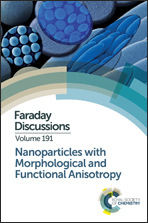Organic–inorganic patchy particles as a versatile platform for fluid-in-fluid dispersion stabilisation†
Abstract
We present a new class of organic–inorganic patchy particles for the efficient stabilization of Pickering foams and emulsions. Using solvent-based heterogeneous precipitation, we decorate inorganic silica particles with discrete domains of water insoluble plant protein (zein). By varying the extent of protein coverage on the silica surface, we tune the pH-dependent interactions of the particles and the interfaces. We observe an optimum foam stabilization, which is attributed to the creation of a slightly positive low effective surface potential from positively charged protein patches and the negatively charged silica surface. The effect of surface coverage on foam stability is in line with the predicted low interfacial potential of the patchy particles in water, which determines the energy of particle adsorption. In emulsions, the increase of the protein amount on the silica particles causes a progressive bridging of the oil droplets into a close-packing configuration due to gelation of the protein patches. Protein-based organic–inorganic surface heterogeneous particles represent a new versatile platform for the stabilization of fluid-in-fluid dispersions and as precursors for the assembly of advanced functional materials.
- This article is part of the themed collection: Nanoparticles with Morphological and Functional Anisotropy

 Please wait while we load your content...
Please wait while we load your content...